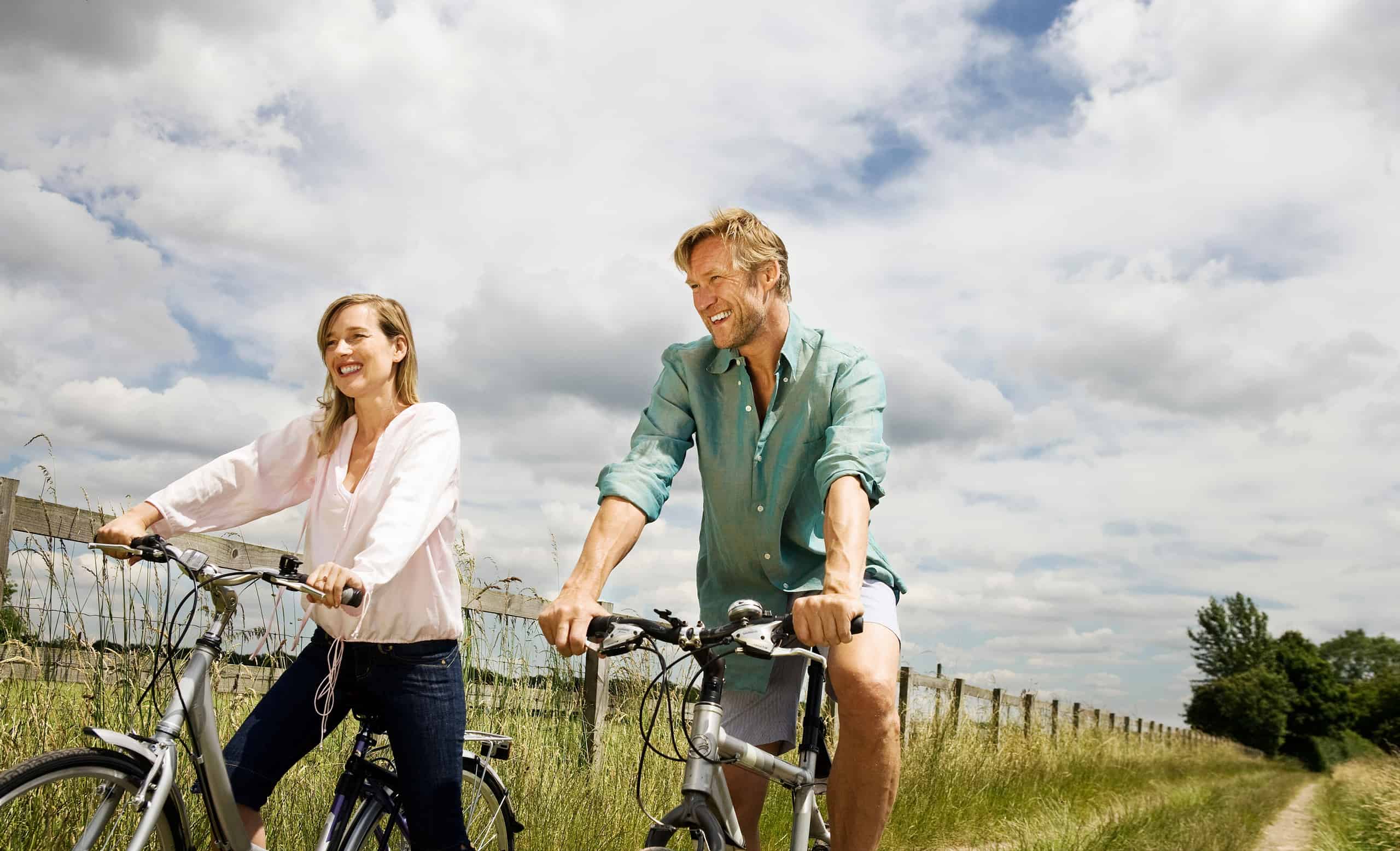Introduction
Cycling is a great way to stay healthy with minimal strain on your back and joints. Unfortunately, many cyclists still experience back pain. This is usually due to incorrect posture, weak core muscles, or a poor bike setup. But don’t worry! With the correct cycling techniques, body mechanics, and core strengthening exercises, you can say goodbye to your back pain.
Check out our guide to learn how to cycle safely and keep your back healthy:
Benefits of Cycling
Cycling: The perfect way to say goodbye to back pain! Low-impact, but with lots of benefits. It can assist with posture, core strength and endurance, cardiovascular health, weight loss, and reduce stress. Let’s explore the other advantages:
- Improved posture
- Increased core strength and endurance
- Improved cardiovascular health
- Weight loss
- Reduced stress
Low-impact exercise
Cycling is an easy exercise that can help people with back aches, neck pains, sciatica and other spinal issues. It can reduce their pain while still enjoying the benefits of exercise. Plus, it can strengthen the muscles around the spine and provide a cardiovascular workout without more harm.
The low-impact of biking is great for various levels of fitness and physical ability without stressing the spine. It’s great for those recovering from injury, starting to get active or with mobility issues.
- Cycling is non-weight bearing and uses natural movements like pedaling and adjusting posture. This puts less strain on your body than running or jumping.
- It also exercises many core muscles, improving posture and coordination.
- Plus, it increases oxygen levels in the muscles to help them heal faster.
Cycling is great for reducing back pain and giving a full-body workout. If you have chronic back or neck pain, don’t miss this opportunity!
Improved cardiovascular health
Cycling is a great low-impact workout for physical and mental health. It can reduce blood pressure, cholesterol and improve circulation. Lung capacity also improves due to cycling, increasing aerobic efficiency. Endurance levels increase with regular cycling too.
Cycling strengthens major muscles, as well as smaller ones in the legs, feet and arms. It can help decrease back pain due to posture or weak muscles. It works against gravity, which means less strain on the lower back. This makes it perfect for those with chronic back pain or joint aches. Cycling doesn’t make it worse, usually it has the opposite effect on joint mobility and back health.
Improved posture
Cycling boosts posture with great perks! Good posture reduces pain in the back and neck, supports breathing, increases energy and blood flow, and provides a balanced appearance. When done right, it strengthens core muscles (abdominals, glutes, lower back) for greater stability when you pedal. Plus, it gives you better control of the bike’s frame and engages multiple muscles when you ride around turns or over obstacles.
Adjust your bike’s handlebars so they’re in line with the seat for a comfy ride during long-distance trips or mountain biking. If you have physical issues, like limited mobility in your hands or arms from an injury or arthritis, make sure to accommodate those when setting up your bike.
Good posture while cycling also enhances balance. When you stay upright, your body can better absorb the shock from bumps in the road and ease the strain on arms and hands. That helps prevent wear-and-tear injuries like tennis elbow and carpal tunnel. Upright posturing will also make pedalling easier on long rides or challenging terrain. It helps you use energy more efficiently and lets you benefit from increased leverage.
Proper Cycling Techniques
Say goodbye to back pain with proper cycling techniques! Cycling is a great way to get exercise and stay in shape. But, if done wrong, it can cause back pain. To avoid this, it is vital to know the proper way to cycle. Here are some basics to help you out:
- Watch out for what you are doing and learn the right techniques.
- Get the most out of your cycling experience!
Adjust your seat
When getting ready to cycle, adjust your seat first! It’s important to get it right; the right height and position will give you a comfy ride and save you from pain in the long run.
Sit on the saddle with your feet on the pedals. Adjust the handlebars until your leg has a slight bend when extended. This should create a 30-degree angle between your leg and handlebar. The middle of the saddle should line up with the ball of your foot. Ensure the nose of your saddle is parallel with the ground.
Adjusting your seat correctly can help with performance, reduce stress on joints due to bad posture, and lessen back pain while cycling. Make a few changes for maximum comfort, and you’ll be ready to go!
Maintain proper posture
Maintain good posture while cycling to avoid back pain and get the most out of your session. Keep your back straight, not slumping down or bending too far back. Your chin should be parallel with the ground, and use a cushion if needed. Adjust your handlebars so that the elbows are bent and close to the body.
Foot position is important too. Keep your pedals level, not rocking side-to-side. For climbing, lower your torso and drop one hip lower than the other. This will help you move better with the terrain and have powerful leg strokes.
Use your core muscles
It’s key to have strong core muscles when cycling. These core muscles include the abs, glutes, lower back and hip flexors. Using these muscles will help you have the correct alignment while riding.
Try to use your core instead of your arms and legs to move forward. Squeeze your abdominal and lower back muscles together throughout the ride and use them for power when climbing hills or sprinting. You can strengthen these muscles by doing exercises such as planks or crunches.
When cycling, make sure you have the right posture. Engage lumbar spine curvature, keep your elbows slightly bent with a wide grip on the handlebars and keep your neck in a neutral position. Doing this will help you gain more from each pedal stroke while reducing the risk of injury and back pain.
Stretches for Back Pain Relief
Cycling is an awesome way to remain active and look after your health. But, it can sometimes cause aches and pains. Fortunately, there are a few stretches that can help with back pain relief. If you do some simple exercises before and after cycling, you can dramatically reduce or even stop back pain.
Here are some stretches to add to your routine:
Cat-Cow stretch
The cat-cow stretch is a great way to ease back pain. It increases flexibility and range of motion. You can do it sitting or standing – a few times each day or once every other day. Here’s how:
- Get on all fours, palms flat and wrists directly under the shoulders.
- Tuck your toes so that your feet are flat. Keep your back straight.
- Inhale – drop your belly and lift your head up. This is cow pose.
- Exhale – draw your belly button up and tuck your chin down. This is cat pose.
- Repeat 4 times – inhale to cow pose and exhale to cat pose.
- Then relax. If desired, roll up into standing position.
Child’s pose
Child’s Pose is a gentle and restorative yoga asana. It relieves tension from the entire back, and is great for relieving back pain and stiffness.
To practice Child’s Pose, start on hands and knees. Spread your knees widely and touch your toes to the ground. Lower yourself down until your buttocks rest between your heels. Let your chest reach towards the floor in front of you. You can relax your arms to either side, or around or behind you, with palms facing up. Stay in this pose for 5-10 breaths or 3-5 minutes. To come out, gently press through palms to rise back up onto all fours. Transition into another posture or rest in Balasana for a few more breaths.
When performing Child’s Pose, remember to breathe and listen to your body. Adjust the intensity depending on how far you wish to stretch. Benefits of regularly practicing Child’s Pose include:
- Improved posture
- Relief from vertebrae spasms
- Improved mental clarity
- Relief from lower back stiffness
- And more!
Cobra pose
Cobra Pose, or Bhujangasana in Sanskrit, is a cycling technique that can help reduce back discomfort. It strengthens the lower back and stretches the spine, and it gives the discs some relief.
To do it:
- Start by lying on your stomach with your legs together and feet flat on the ground. Place your palms flat beside your ribs, and keep your elbows by your sides.
- As you inhale, press your hands into the ground and straighten your arms, lifting your chest off the floor until you feel comfortable. You should feel a gentle stretch in your belly and along your front body. Hold this pose for 15-30 seconds or up to one minute for a deeper stretch.
This pose helps relax tight muscles in the upper and middle of your spine, which can be caused by sitting in a poor posture for long periods. People also find it helpful in treating compression of the vertebrae, bulging disks, and weak abdominal muscles that lead to back pain from bad posture habits.
Conclusion
Cycling is a great way to travel and exercise to avoid back pain. With some modifications, it can be done safely. You can prevent future episodes with correct cycling technique and cadence.
It is vital to warm-up and cool-down before and after cycling. Daily stretching is also vital.
Most important is to make sure your bike seat is in the right position. That way, you will be comfortable and maximize performance without back pain. It looks like biking is one of the best ways to avoid back aches and pains!
Frequently Asked Questions
Q: Can cycling aggravate my back pain?
A: It depends on your cycling technique. If you have poor posture or bike set up, cycling can be harmful to your back. However, with proper form and adjustments, cycling can actually help alleviate back pain.
Q: What is the correct posture for cycling to prevent back pain?
A: Your back should be relatively straight, with a slight curve in the lumbar region. Avoid rounding your spine or arching your back. Keep your shoulders relaxed and your arms slightly bent.
Q: How do I adjust my bike for optimal posture?
A: Adjust your saddle so that your leg has a slight bend when your foot is on the bottom pedal. Make sure your handlebars are at a suitable height that allows for a comfortable position with a straight back.
Q: What exercises can I do to strengthen my back for cycling?
A: Some exercises that can help prevent back pain while cycling include planks, bird dogs, and bridges. These exercises target the core muscles, which play a crucial role in supporting your back while you cycle.
Q: How can I avoid overusing my back muscles while cycling?
A: Focus on pedaling with your legs rather than pulling up on the pedals with your feet. Avoid cycling in a low gear for an extended period, as this can put strain on your back muscles. Standing up and stretching periodically can also help prevent overuse injuries.









